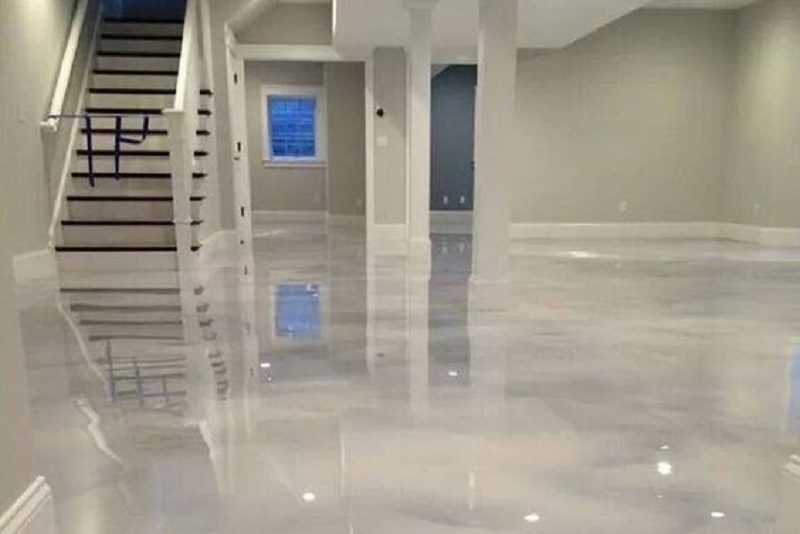Epoxy flooring is generally more cost-effective than tile flooring. The materials and installation costs of epoxy tend to be lower.
Choosing the right flooring can be a crossroad for homeowners and businesses looking to balance aesthetics, durability, and cost. Epoxy flooring emerges as a budget-friendly alternative to traditional tile, luring customers with its seamless finish and low maintenance demands. Often used in commercial settings, epoxy’s resilience to staining and high traffic makes it an economical choice over the long term.
Its affordability shines particularly in large spaces where the cost of tiles, along with the complexity of installation, can quickly escalate. Opting for epoxy means investing in a floor that not only stands up to wear and tear but also offers customizable looks without breaking the bank. Balanced against the elegant, timeless appeal of tile, epoxy presents a practical solution where function and finance collide.

Introduction To Epoxy And Tile Flooring
Epoxy flooring is a seamless resin-coated floor. It is known for its durability and stain resistance. This type of flooring involves applying a liquid epoxy resin over concrete. Once cured, it creates a smooth, finished surface that can last for years.
Tile flooring, on the other hand, consists of individual tiles made of ceramic, porcelain, or stone. These are installed with grout in between. Tiles offer a variety of designs and are well-suited for areas with high moisture.

Initial Costs And Installation
Epoxy flooring can be more cost-effective than tile. The material costs for epoxy are generally lower. Epoxy is a resin and hardener mix, often sold in bulk. Conversely, tile costs can vary widely depending on the type and quality.
Tiles might demand more money for intricate designs and higher quality materials. Labor costs also play a big role in the overall expense. Epoxy flooring installation takes less time, resulting in lower labor costs. In contrast, tile installation is labor-intensive and takes longer.
| Flooring Type | Material Cost | Labor Cost | Installation Time |
|---|---|---|---|
| Epoxy | Lower | Lower | Shorter |
| Tile | Higher | Higher | Longer |
The size of the floor also affects the cost. Larger areas may benefit from epoxy’s efficiency. Smaller tiles could increase the overall price. Each option’s cost can fluctuate based on the flooring area.
Long-term Cost Analysis
Durability and Lifespan Comparisons:
Choosing between epoxy flooring and tile impacts future expenses. Epoxy generally boasts a longer lifespan, enduring up to 30 years. In contrast, ceramic tiles may crack or chip, necessitating more frequent replacements, typically every 10 to 20 years. This means homeowners could incur higher costs with tile flooring maintenance over decades.
- Both flooring types require upkeep; epoxy needs occasional resealing.
- Tile demands regular grout cleaning to prevent mold and staining.
- Spills on epoxy can be wiped easily, reducing maintenance time.
| Flooring Type | Repair Frequency | Replacement Cost |
|---|---|---|
| Epoxy | Less often | Lower over time |
| Tile | More often | Higher over time |

Aesthetic And Functional Considerations
Choosing between epoxy flooring and tile involves both style and cost. Epoxy offers seamless finishes in various colors and patterns. With epoxy, customization is easy, presenting endless design possibilities. In contrast, tile comes in different shapes, sizes, and materials. Each option carries unique installation charges and materials costs.
The visual appeal of a floor can influence price. Epoxy’s continuous surface can hide imperfections and offers a glossy, high-end look. Tiles provide a classic touch, with costs varying based on the type chosen. Natural stone tiles typically cost more than ceramic or porcelain. Aesthetics drive potential costs, impacting the decision.
In terms of functionality, both flooring types have advantages. Epoxy is durable, resistant to stains, and easy to maintain, boosting its value. Tiles are hard-wearing and offer repair flexibility; a single tile can be replaced if damaged. Consider these functional benefits against long-term value to make an informed choice.
The Verdict: Which Is More Economical
Understanding the total cost of ownership helps determine the more economical choice between epoxy flooring and tile. The initial installation cost for epoxy flooring generally runs lower than that for tile. However, long-term maintenance and durability play crucial roles in overall affordability.
Considering longevity, epoxy often outlasts standard tiles, thus decreasing replacement frequency. Epoxy’s seamless surface also means fewer cracks for dirt collection, reducing cleaning expenses and effort. Additionally, epoxy is resistant to water, chemicals, and stains, which further cuts down on maintenance costs and prolongs floor life.
- Epoxy Flooring: Lower installation costs, less maintenance, higher durability.
- Tile: Higher installation costs, more maintenance, potentially shorter lifespan.
Different spaces require distinct considerations. For high-traffic areas, such as industrial settings or garages, epoxy stands as the top recommendation for its toughness. Tiles may suit homes, where style variety is often valued more than sheer endurance. Always weigh individual needs against initial costs and potential upkeeps.
Conclusion
Selecting the right flooring is crucial for both aesthetics and budget. Epoxy emerges as a cost-effective contender, often outperforming tile in affordability and durability. Embrace this savvy choice for a sleek, enduring surface without breaking the bank. Let epoxy floor your space with value.




